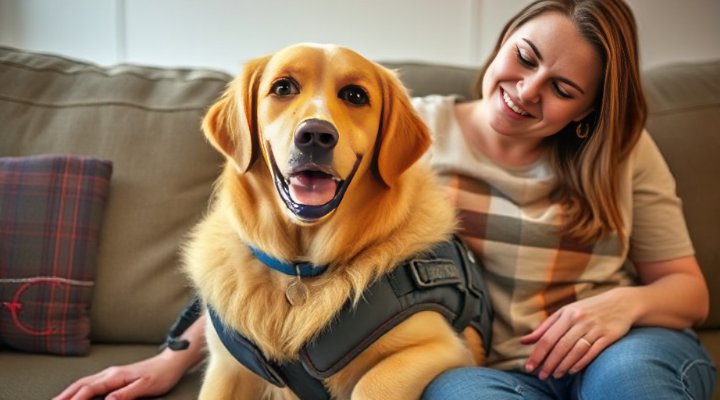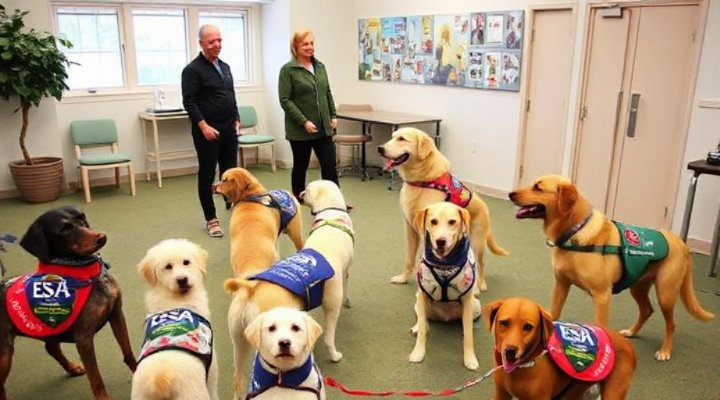Emotional support animals, particularly dogs, have become invaluable companions for individuals dealing with mental health challenges. Unlike service dogs that perform specific tasks, ESA dogs provide comfort simply through their presence. However, proper training is essential to ensure they can effectively support their owners. In this guide, we’ll explore comprehensive ESA dogs training tips for emotional support that will help you build a reliable healing companion.

Understanding the Role of an Emotional Support Dog
Before diving into training techniques, it’s crucial to understand what makes an effective ESA dog. These special companions provide emotional stability and comfort to individuals with conditions like anxiety, depression, or PTSD. While they don’t require the same level of training as therapy dogs, they still need proper socialization and obedience training to be reliable in various situations.
Key Characteristics of a Good ESA Dog
The ideal emotional support dog possesses certain innate qualities that make them particularly suited for this role. Most importantly, they should be naturally calm, affectionate, and responsive to human emotions. Breeds like Golden Retrievers, Labradors, and Cavalier King Charles Spaniels often excel in this role, but any dog with the right temperament can become an excellent ESA.

Essential ESA Dogs Training Tips for Emotional Support
Training an emotional support dog requires patience, consistency, and positive reinforcement. Here are the fundamental areas to focus on:
1. Basic Obedience Training
Every ESA dog should master basic commands like sit, stay, come, and heel. These foundational skills ensure your dog remains under control in public settings. Consider enrolling in dog training classes to establish these basics effectively.
2. Emotional Sensitivity Training
Unlike regular pets, ESA dogs need to recognize and respond to emotional cues. You can develop this by rewarding your dog when they naturally comfort you during stressful moments. Gradually, they’ll learn to offer comfort on cue.

3. Public Behavior Training
While ESA dogs don’t have the same public access rights as service dogs, they should still behave appropriately in various environments. Practice taking your dog to different locations while maintaining calm behavior, similar to techniques used in reactive dog training programs.
Advanced Training Techniques for ESA Dogs
Once your dog masters the basics, you can introduce more specialized emotional support skills:
1. Deep Pressure Therapy
This technique teaches your dog to apply gentle pressure with their body to help alleviate anxiety attacks. Start by rewarding your dog for leaning against you, then gradually shape the behavior.
2. Alert Behaviors
Some ESA dogs can learn to recognize signs of distress before their owners do. While not as precise as service dog alerts, this can be incredibly valuable for mental health management.

Maintaining Your ESA Dog’s Skills
Training is an ongoing process. Regular practice sessions and occasional refresher courses will keep your dog’s skills sharp. Remember, the bond between you and your ESA dog is the foundation of their effectiveness. Spend quality time together, and consider activities that strengthen your connection, like those suggested in our dog training classes article.
For those considering professional help, many dog training programs offer specialized courses for emotional support animals. These can be particularly helpful if you’re struggling with specific aspects of training.

Legal Considerations and Certification
While there’s no official certification required for emotional support animals, proper training documentation can be helpful. Always check current regulations as they vary by location. For more information on certification processes, you might find our article on therapy dog certification helpful, as some principles overlap.
Keywords Related to ESA Dogs Training:
ESA dog training, emotional support dog training, therapy dog training, mental health support dogs, ESA certification, service dog vs ESA, emotional support animal laws, best breeds for ESA dogs, training anxious dogs, canine mental health support

